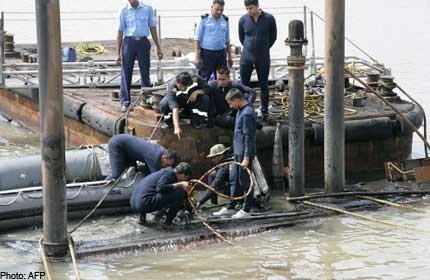Indian navy struggles to find survivors after worst naval blast

INDIA - Indian Navy divers and engineers struggled to find 18 crew members feared dead after a submarine explosion as Prime Minister Manmohan Singh expressed "deep pain" over the incident, the navy's worst in decades.
The INS Sindhurakshak, a diesel-powered submarine, was partly submerged after explosions set off a fire early on Wednesday.
Dr Singh, in a speech to mark India's 67th Independence Day, said celebrations this year were tinged with sorrow.
"The accident is all the more painful because the navy had recently achieved two major successes in the form of its first nuclear submarine, the INS Arihant, and the aircraft carrier, the INS Vikrant," he said on Thursday.
"Eighteen brave sailors are feared to have lost their lives... We pay homage to the brave hearts we have lost."
The navy said poor visibility and other factors - including the fact that parts of the vessel melted in the fire - were hampering efforts by divers working on the submarine, which was docked at a naval dockyard in Mumbai.
Pumps were being used to draw out water so that the submarine could be brought to the surface for investigations into the cause of the accident.
"Trapped personnel have not yet been sighted or recovered," the navy said of the 18 crewmen, whose families have been waiting for news of their fate.
The submarine had returned from Russia in April following a two-year refit costing US$80 million (S$101 million).
Commissioned in 1997, the Russian-built Sindhurakshak had been fitted with anti-ship and anti-land attack cruise missile systems, and was fully armed at the time of the explosions and fire.
The Indian Navy just notched up two successes with the launch of the aircraft carrier Vikrant on Monday and the activation of a nuclear reactor on the submarine Arihant two days earlier, on Saturday.
The loss of a submarine is a major setback for the navy, which has been trying to bulk up its capabilities and better patrol its maritime border and the Indian Ocean in the wake of China's naval build-up.
A board of inquiry consisting of experts has been set up, but speculation continues over whether the explosion was caused by human error or material malfunction.
"It could be due to failure to comply with standard operating procedures, or there was a material failure or a combination of both," said retired Vice-Admiral Arun Kumar Singh, who carried out an operational readiness inspection of the Sindhurakshak in 1999.
"The submarine had massive lead acid batteries that give off hydrogen gas. Maybe it reached a critical level of concentration," he added.
"It is a very tragic event that has happened," said retired Commodore S. Govind, formerly a principal director of submarine operations.
"Nobody in the navy has seen or experienced such a thing before. We are all in the dark."
The incident is expected to have an impact on the preparedness of the Indian Navy, which has 14 other submarines. Two are being refitted, so the navy is left with 12, which were acquired between 1985 and 2000.
India's efforts to boost its submarine fleet have been hit by many delays, both technical and financial. Six Scorpene submarines still under construction in India are running four years behind schedule.
"There is no replacement in sight. This is a very big disaster," said Vice-Adm Singh.

Get a copy of The Straits Times or go to straitstimes.com for more stories.